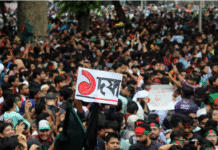It belongs to the planet and its peoples

For many this idea might ring naïve, but inhered within this premise is a very post-national argument which allows us to transcend the limits that the discourses of nationalism impinges on us – going round and round the mulberry bush of “national growth and development” parley and its banal logic.
Picketing at ground zero
Typically, the central part of the activism around Rampal is what some might call bourgeois activism, which must also be problematised. The narratives that such activism produces tend to be confined within the narrow corridors of nationalism, patriotism, where the regime and the protestors both claim to be “defending the nation and its people.” It then becomes easier for national governments, especially authoritarian ones, to trip these discourses by producing contentious arguments that challenge the very nationalism of the protestors, and any contrarian arguments are flagged as anti-national, even seditious.
But, more importantly, when bourgeois activists take centre stage, they push away the real faces of the displaced people who are directly affected by such a project. It is, then, easier for those with vested interests to derail them by issuing veiled threats, or arresting them on some trumped up charges, or in extreme cases, through “disappearances.” Most of these kinds of targeting happen to individuals who are deemed to be the central voices of dissent. It has happened in the context of Rampal too. Such manoeuvres throw off the activists in two ways — one, they become embroiled in a new fight for their fellow-activist thus threatened, ergo derailing the main discourse. And, two, they inject an aura of fear resulting in self-censorship. The language of dissent is affected. This affectation weakens the whole movement.
Whereas, when the people who are at risk lead such movements, some of these problems can be avoided. For example, in the case of the Dakota Access Pipeline project, through the Standing Rock Sioux Reservation, it is the Native American people who are at forefront of the protests, as it should be. Since they live on those lands, it helps the protest to occupy a geographical space at the heart of the problem, which is critical. Bourgeois activists, on the other hand, typically fight from ‘faraway’ spaces. In Zadie Smith’s words, “the aristocrat and the proletariat have different relations to the ground beneath their feet,” which is why such alienation doesn’t help centring it where it should be centred at – ground zero. It is then imperative that the very people whose livelihoods are most threatened are in the frontlines of such protests, and it is their voices that should get primacy, it is their faces that should be across all media. Because, it is in their voices that we will hear the distress, and in their faces we will see the despair. We have seen this happen in the Singur-Nandigram (West Bengal) protests too, where the locals occupied ground zero.

Internationalisation of environmental justice
The aforementioned premise also allows us to argue that a decision regarding environmental issues –that puts the whole planet at peril –is beyond the pomposity of nationalistic ardour. It allows for global alliances on environmental or climate justice, transcends global neo-liberal clientelistic arguments, and avoids getting trapped in the non-productive discourses of diplomacy and its tired rhetoric.
Frantz Fanon puts it succinctly in his book, The Wretched of the Earth:
“When such parties [nationalistic parties] are questioned on the economic programme of the state that they are clamouring for…they are incapable of replying, because, precisely, they are completely ignorant of the economy of their own country.
“This economy has always developed outside the limits of their knowledge. They have nothing more than an approximate, bookish acquaintance with the actual and potential resources of their country’s soil and mineral deposits; and therefore they can only speak of these resources on a general and abstract plane.”
This rings very true in the case of Rampal and all the explanations and excuses that have been forwarded, which are primarily “outside the limits of their knowledge.” These narratives fail to answer the simple question: “development” at what cost?
Thus challenging the national government’s right to take a decision unitarily on the thermal power plant in Sundarban, as it affects the whole planet, and all its peoples, is a very critical demand. The Sundarban is more than just a mangrove forest that happens to lie within the national boundaries of Bangladesh and India, it is a bio-shield against natural disasters, and a carbon sink absorbing more than four billion tonnes of carbon dioxide from the atmosphere, as per a recent study. It is also the home of one the most amazing biodiversity that keeps our planet safe.
Renuka Saroha, of 350.org, makes a compelling argument about the mammoth costs that we will continue to pay when the coal-fired power plant is in operation.
“It is inevitable this entire area will become an industrial hub. The cumulative damage to the entire ecosystem is going to be irreversible.”
Once such an argument is deployed, a concentric circle of supranational resistance could be shored up, asking for supranational legislations. The protest can then transcend national boundaries.
The role of the bourgeois activists should be to create alliances with all ongoing global climate justice movements, a conflation with the likes of DAPL, Flint, anti-fracking protests. Other movements should also stand up for the Rampal protests, as should Rampal for others. Such solidarities make all local protests more powerful. When like-minded movements are in solidarity, it helps create a much-needed global discourse, where the international community’s hand is forced; they are not allowed to wash their hands off citing these as “a nation’s internal matter,” in typical diplo-speak.
While the current protest has garnered some international attention and a handful of environmental groups like the Friends of the Earth, the Sierra Club, and 350.org have come forward, there still needs to be a show of solidarity across the global protests for environmental justice — a people to people solidarity, a movement to movement solidarity, where slogans and graffiti across movements bring attention to all the concurrent movements, so that the local people who are putting their bodies and wellbeing on the line know that they are not alone. That, like them, there are bodies in the line of fire, fighting the same fight.
And, as grave as it might be, this is how Hegel puts it:
“It is solely by risking life that freedom is obtained.”
Source: The Daily Star









